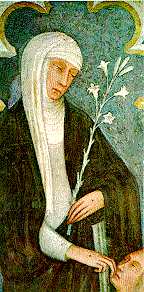Readings:
Preface of a Saint (2)
-
[Common of a Theologian and Teacher]
[Common of a Monastic or Professed Religious]
[Of the Holy Trinity]
[For Prophetic Witness in the Church]
PRAYER (traditional language)
Almighty and everlasting God, who didst kindle the flame of thy love in the heart of thy servant Catherine of Siena: Grant unto us the same strength of conviction and power of love that, as we rejoice in her triumph, we may profit by her example; through Jesus Christ our Lord. Amen.
PRAYER (contemporary language)
Almighty and everlasting God, who kindled the flame of your love in the heart of your servant Catherine of Siena: Grant unto us the same strength of conviction and power of love that, as we rejoice in her triumph, we may profit by her example; through Jesus Christ our Lord. Amen.
Lessons revised in Lesser Feasts & Fasts 2024
Return to Lectionary Home Page
Webmaster: Charles Wohlers
Last updated: 1 March 2025
CATHERINE OF SIENA
REFORMER AND SPIRITUAL TEACHER (29 APR 1380)
 Catherine Benincasa,
born in 1347, was the youngest (one of my sources says the 23rd) of twenty-five
children of a wealthy dyer of Sienna (or Siena). At the age of six, she
had a vision of Christ in glory, surrounded by His saints. From that time
on, she spent most of her time in prayer and meditation, over the opposition
of her parents, who wanted her to be more like the average girl of her
social class. Eventually they gave in, and at the age of sixteen she joined
the Third Order of St. Dominic (First Order = friars, Second Order = nuns,
Third Order = laypersons), where she became a nurse, caring for patients
with leprosy and advanced cancer whom other nurses disliked to treat.
Catherine Benincasa,
born in 1347, was the youngest (one of my sources says the 23rd) of twenty-five
children of a wealthy dyer of Sienna (or Siena). At the age of six, she
had a vision of Christ in glory, surrounded by His saints. From that time
on, she spent most of her time in prayer and meditation, over the opposition
of her parents, who wanted her to be more like the average girl of her
social class. Eventually they gave in, and at the age of sixteen she joined
the Third Order of St. Dominic (First Order = friars, Second Order = nuns,
Third Order = laypersons), where she became a nurse, caring for patients
with leprosy and advanced cancer whom other nurses disliked to treat.
She began to acquire a reputation as a person of insight and sound judgement, and many persons from all walks of life sought her spiritual advice, both in person and by letter. (We have a book containing about four hundred letters from her to bishops, kings, scholars, merchants, and obscure peasants.) She persuaded many priests who were living in luxury to give away their goods and to live simply.
In her day, the popes, officially Bishops of Rome, had been living for about seventy years, not at Rome but at Avignon in France, where they were under the political control of the King of France (the Avignon Papacy, sometimes called the Babylonian Captivity of the Papacy, began when Philip the Fair, King of France, captured Rome and the Pope in 1303). Catherine visited Avignon in 1376 and told Pope Gregory XI that he had no business to live away from Rome. He heeded her advice, and moved to Rome. She then acted as his ambassador to Florence, and was able to reconcile a quarrel between the Pope and the leaders of that city. She then retired to Siena, where she wrote a book called the Dialog, an account of her visions and other spiritual experiences, with advice on cultivating a life of prayer.
After Gregory's death in 1378, the Cardinals, mostly French, elected an Italian Pope, Urban VI, who on attaining office turned out to be arrogant and abrasive and tyrannical, and perhaps to have other faults as well. The Cardinals met again elsewhere, declared that the first election had been under duress from the Roman mob and therefore invalid, and elected a new Pope, Clement VII, who established his residence at Avignon. Catherine worked tirelessly, both to persuade Urban to mend his ways (her letters to him are respectful but severe and uncompromising -- as one historian has said, she perfected the art of kissing the Pope's feet while simultaneously twisting his arm), and to persuade others that the peace and unity of the Church required the recognition of Urban as lawful Pope. Despite her efforts, the Papal Schism continued until 1417. It greatly weakened the prestige of the Bishops of Rome, and thus helped to pave the way for the Protestant Reformation a century later.
Catherine is known (1) as a mystic, a contemplative who devoted herself to prayer, (2)
as a humanitarian, a nurse who undertook to alleviate the suffering of the poor and the
sick; (3) as an activist, a renewer of Church and society, who took a strong stand on the
issues affecting society in her day, and who never hesitated (in the old Quaker phrase)
"to speak truth to power"; (4) as an adviser and counselor, with a wide range of
interests, who always made time for troubled and uncertain persons who told her their
problems -- large and trivial, religious and secular.
by James Kiefer